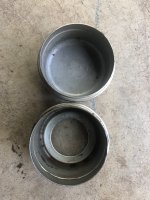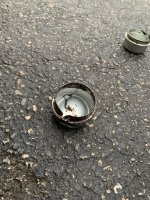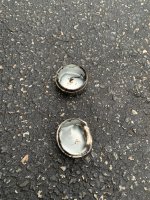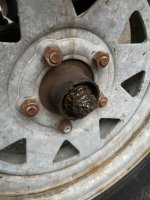OH BOY it's story time.
So I pulled one of the caps out of the 2 pack I bought today and grabbed a nice piece of 2" PVC, a scrap of 2x4 and a rubber mallet.
I beat the **** out of that thing but it would not go on. Eventually it deformed the lip and cap #3 was ruined.
On to cap #4. Last one, so I had to try something different. So I brought it inside and gave it a slightly beveled edge with my bench grinder. I used some high grit sandpaper to smooth out the grinder's work. Then I went to hammer it on. And after enough hammer, guess what! It friggin worked! It finally slipped on. So I guess that's the secret.
BUT WAIT, there's more! I didn't get out of the water until after 11 so I was driving home with roads to myself. I hit a bumper section and I swear I heard something fall off my truck. Yeah yeah we all know where this story is going. It wasn't the one I hammered in though! It was the other one!
The one I hammered in was being hammered in because one of the last times I used the boat trailer, it disappeared. So I guess I need to go buy ANOTHER four caps so I can get one on tight on the new side!!
I was able to get the one that fell out mostly back in by hand, then I hammered it with a wrench to get it fully inserted. Then by the time I got home, it was almost falling off again. What a pain in the ass! No idea why these caps are self-ejecting after many many years.
At this point I’ve removed and installed 100 or so caps (4 x25 yrs) on my tandem trailer and have only bent 2-3 and lost two.
The caps are “interference” fits that take some finesse, to install. If you find yourself smashing the ***** out of them your doing something wrong or the part is out of spec.
As an interference fit, your dealing with pretty tight tolerances. If you have to “grind” to fit your definitely out of tolerance and failure is guaranteed from the get go.
Couple of things I’ve found over the years…..
There are “good” (heavy material) caps and there are “junk” (light material) caps. The difference between 0.025” and 0.030 material is substantial in its ability to retain its shape which brings up the next point.

Most of the time (95%) the “drive sleeve” is bent or out of round right out of the box.
You will never drive them w/o distorting or outright destroying them unless corrected.
Spend the time to inspect, measure and correct the issue prior to installation. I use a pair of dial calipers and spin the drive sleeve in the jaws to measure the run out.
If out of round, quite often you can you use a wooden dowel, run around the inside with hand pressure to work out the kinks. If too bad, I resort to a pair of needle nose pliers to adjust.
One other thing… get rid of the dead blow for installation. The rubber is absorbing a significant portion of the drive energy. A 32oz. ball peen hammer works like a charm

























